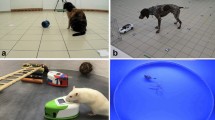Abstract
Our group took an initial decision not to discuss the subjective experiences of animals on the grounds that we could see no way of studying them. At first sight, this may seem as though we were avoiding the central issue of the conference altogether, but we took our decision in the belief that by trying to discover the processes, cognitive or otherwise, that lie behind animal behavior, we stood the best chance of being able to generate testable hypotheses. We were thus quite happy to talk about the kinds of cognitive representations that animals might have, but only as long as they could be operationally defined and distinguished by some sort of experiment, however far-fetched. In view of the title given to our group, we took it as our brief to look at the real tasks which animals perform in nature to see if they tell us anything about the rules or algorithms which animals actually use.
Access this chapter
Tax calculation will be finalised at checkout
Purchases are for personal use only
Preview
Unable to display preview. Download preview PDF.
Similar content being viewed by others
References
Abegglen, J.J. 1981. On Socialization in Hamadryas Baboons. East Brunswick: Associated University Presses, in press.
Cowie, R.J.; Krebs, J.R.; and Sherry, D.F. 1981. Food hoarding by marsh tits. Anim. Behav., in press.
Dale, R.H.I. 1981. Parallelarm maze performance of sighted and blind rats: Spatial memory and maze structure. Behav. Anal. Lett.: in press.
Dawkins, M. 1971. Perceptual changes in chicks: another look at the ’search image1 concept. Anim. Behav. 19.: 556–574.
Dawkins, M. 1980. Animal Suffering: the Science of Animal Welfare. London: Chapman and Hall.
Dawkins, R., and Krebs, J.R. 1979. Arms races between and within species. Proc. Roy. Soc. Lond. B 205: 489–511
Garcia, J.; Kimmeldorf, D.J.; and Koelling, R.A. 1955. Conditioned aversion to saccharin resultinq from exposure to gamma radiation. Science 122: 158–159.
Green, D.M., and Swets, J.A. 1966. Signal Detection Theory and Psychophysics. New York: Wiley.
Harley, C. 1981. Learning the ESS. J. Theor. Biol.: in press.
Herrnstein, R.J. 1970. On the law of effect. J. exp. Anal. Behav. 13: 243–266.
Krebs, J.R.; Kacelnik, A.; and Taylor, P. 1978. Tests of optimal sampling by foraging great tits. Nature 275: 27–31.
MacArthur, R.H., and Wilson, E.O. 1967. The Theory of Island Biogeography. Princeton: Princeton University Press.
O’Keefe, J., and Nadel, L. 1979. Precis of O’Keefe and Nadel’s “The hippocampus as a cognitive map.” Behav. Brain Sci. 2: 487–533.
Olton, D.S., and Samuelson, R.J. 1976. Remembrance of places passed: spatial memory in rats. J. Exp. Psychol. Anim. Behav. Proc. 2: 97–116.
Olton, D.S.; Becker, J.T.; and Handelmann, G.E. 1979. Hippocampus, space, and memory. Behav. Brain Sci. 2: 313–365.
Packer, C. 1977. Reciprocal altruism in Papio anubis. Nature: 265, 441–443.
Perrins, C.M., and Moss, D. 1975. Reproductive rates in the great tit. J. Anim. Ecol. 44: 695–706.
Reither, F. 1980. Selfreflective cognitive processes: its characteristics and effects. Paper presented at the X XII International Congress of Psychology, Leipzig.
Reither, F. 1981. About thinking and acting of experts in complex situations. Simul. Games, in press.
Roberts, W.A., and Dale, R.H.I. 1981. Remembrance of places lasts: proactive inhibition and patterns of choice in rat spatial memory. Learn. Motiv.: in press.
Rothstein, S.I. 1975. Evolutionary rates and host defenses against brood parasites. Am. Natural. 109: 161–176.
Rozin, P. 1976. The selection of food by rats, humans and other animals. In Advances in the Study of Behavior, eds. J.S. Rosenblatt, R.A. Hinde, E. Shaw and C. Beer, vol. 6, pp. 21–76. New York: Academic Press.
Sherry, D.F.; Krebs, J.R.; and Cowie, R.J. 1981. Evidence for memory of food storage sites in the marsh tit. Anim. Behav.: in press.
Thorpe, W.H. 1963. Learning and Instinct in Animals. London: Methuen.
Tinbergen, L. 1960. The natural control of insects in pine woods. I. Factors influencing the intensity of pre-dation in song birds. Arch. Neerl. Zool. 13: 165–343.
Tolman, E.C. 1948. Cognitive maps in rats and men. Psychol. Rev. 55: 189–208.
Trivers, R.L. 1971. The evolution of reciprocal altruism. Q. Rev. Biol. 46: 35–57.
Uexkull, J. von. 1934. Streifztige durch die Umwelten von Tieren und Menschen. Berlin: Springer. Translated in Instinctive Behavior, 1957, ed. C.H. Schiller. London: Methuen.
Welker, C. 1981. Natural and dependent rank of female crab-eating monkeys (Macaca fascisularis) in captivity. In Proceedings of the International Primate Society. Berlin: Springer, in press.
Wiley, R.H., and Hartnett, S.A. 1980. Mechanisms of spacing in groups of juncos: measurement of behavioural tendencies in social situations. Anim. Behav. 28: 1005–1016.
Editor information
Rights and permissions
Copyright information
© 1982 Dr. S. Bernhard, Dahlem Konferenzen, Berlin
About this paper
Cite this paper
Dawkins, M. et al. (1982). Evolutionary Ecology of Thinking State of the Art Report. In: Griffin, D.R. (eds) Animal Mind — Human Mind. Life Sciences Research Reports, vol 21. Springer, Berlin, Heidelberg. https://doi.org/10.1007/978-3-642-68469-2_18
Download citation
DOI: https://doi.org/10.1007/978-3-642-68469-2_18
Publisher Name: Springer, Berlin, Heidelberg
Print ISBN: 978-3-642-68471-5
Online ISBN: 978-3-642-68469-2
eBook Packages: Springer Book Archive




